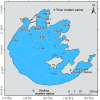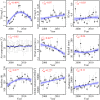Effects of climatically-modulated changes in solar radiation and wind speed on spring phytoplankton community dynamics in Lake Taihu, China
- PMID: 30289946
- PMCID: PMC6173452
- DOI: 10.1371/journal.pone.0205260
Effects of climatically-modulated changes in solar radiation and wind speed on spring phytoplankton community dynamics in Lake Taihu, China
Abstract
Many studies have focused on the interactive effects of temperature increases due to global warming and nutrient enrichment on phytoplankton communities. Recently, non-temperature effects of climate change (e.g., decreases in wind speed and increases in solar radiation) on large lakes have received increasing attention. To evaluate the relative contributions of both temperature and non-temperature effects on phytoplankton communities in a large eutrophic subtropical shallow lake, we analyzed long-term monitoring data from Lake Taihu, China from 1997 to 2016. Results showed that Lake Taihu's spring phytoplankton biovolume and composition changed dramatically over this time frame, with a change in dominant species. Stepwise multiple linear regression models indicated that spring phytoplankton biovolume was strongly influenced by total phosphorus (TP), light condition, wind speed and total nitrogen (TN) (radj2 = 0.8, p < 0.01). Partial redundancy analysis (pRDA) showed that light condition accounted for the greatest variation of phytoplankton community composition, followed by TP and wind speed, as well as the interactions between TP and wind speed. Our study points to the additional importance of non-temperature effects of climate change on phytoplankton community dynamics in Lake Taihu.
Conflict of interest statement
The authors have declared that no competing interests exist.
Figures





Similar articles
-
[Analysis of Influencing Factors of Chlorophyll-a in Lake Taihu Based on Bayesian Network].Huan Jing Ke Xue. 2023 May 8;44(5):2592-2600. doi: 10.13227/j.hjkx.202206323. Huan Jing Ke Xue. 2023. PMID: 37177933 Chinese.
-
Long-term dynamics and drivers of phytoplankton biomass in eutrophic Lake Taihu.Sci Total Environ. 2018 Dec 15;645:876-886. doi: 10.1016/j.scitotenv.2018.07.220. Epub 2018 Jul 24. Sci Total Environ. 2018. PMID: 30032083
-
Effects of wind wave turbulence on the phytoplankton community composition in large, shallow Lake Taihu.Environ Sci Pollut Res Int. 2015 Aug;22(16):12737-46. doi: 10.1007/s11356-015-4535-2. Epub 2015 Apr 28. Environ Sci Pollut Res Int. 2015. PMID: 25913313
-
Is the future blue-green? A review of the current model predictions of how climate change could affect pelagic freshwater cyanobacteria.Water Res. 2012 Apr 1;46(5):1364-71. doi: 10.1016/j.watres.2011.12.018. Epub 2011 Dec 14. Water Res. 2012. PMID: 22244968 Review.
-
Storm impacts on phytoplankton community dynamics in lakes.Glob Chang Biol. 2020 May;26(5):2756-2784. doi: 10.1111/gcb.15033. Epub 2020 Mar 5. Glob Chang Biol. 2020. PMID: 32133744 Free PMC article.
Cited by
-
Long-term dynamics of placozoan culture: emerging models for population and space biology.Front Cell Dev Biol. 2025 Jan 8;12:1514553. doi: 10.3389/fcell.2024.1514553. eCollection 2024. Front Cell Dev Biol. 2025. PMID: 39845085 Free PMC article.
References
-
- Bopp L, Resplandy L, Orr JC, Doney SC, Dunne JP, Gehlen M, et al. Multiple stressors of ocean ecosystems in the 21st century: projections with CMIP5 models. Biogeosciences. 2013; 10:6225–45.
-
- Elliott JA. The seasonal sensitivity of cyanobacteria and other phytoplankton to changes in flushing rate and water temperature. Glob Change Biol. 2010; 16(2):864–76.
-
- Sommer U, Lengfellner K. Climate change and the timing, magnitude, and composition of the phytoplankton spring bloom. Glob Change Biol. 2008; 14(6):1199–208.
-
- O’Neil J, Davis T, Burford M, Gobler C. The rise of harmful cyanobacteria blooms: the potential roles of eutrophication and climate change. Harmful Algae. 2012; 14:313–34.
Publication types
MeSH terms
LinkOut - more resources
Full Text Sources

